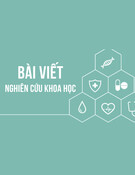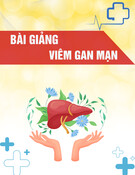
95
Tạp chí Y Dược học - Trường Đại học Y Dược Huế - Số 4, tập 12, tháng 8/2022
Nghiên cứu nồng độ Interleukin-6 huyết thanh trên bệnh nhân viêm
khớp dạng thấp
Phan Thị Minh Phương1*, Bùi Quang Vinh2, Nguyễn Thị Dung3, Phan Ngọc Đan Thanh1
(1) Bộ môn Miễn dịch - Sinh lý bệnh, Trường Đại học Y - Dược, Đại học Huế
(2) Phòng bảo vệ sức khỏe cán bộ tỉnh Thừa Thiên Huế
(3) Bộ môn Hóa sinh, Trường Đại học Y - Dược, Đại học Huế
Tóm tắt
Đặt vấn đề: Tế bào lympho T hỗ trợ 17 (Th17) chế tiết các Interleukin trong đó có Interleukin-6 thúc
đẩy quá trình bệnh lý ở bệnh nhân viêm khớp dạng thấp. Do đó, nồng độ Interleukin-6 huyết thanh có thể
liên quan với các đặc điểm lâm sàng, cận lâm sàng của viêm khớp dạng thấp. Mục tiêu: Xác định nồng
độ Interleukin-6 huyết thanh ở bệnh nhân viêm khớp dạng thấp và khảo sát mối liên quan giữa nồng độ
Interleukin-6 huyết thanh với một số đặc điểm lâm sàng, cận lâm sàng ở bệnh nhân viêm khớp dạng thấp.
Phương pháp nghiên cứu: Nghiên cứu mô tả cắt ngang trên 41 bệnh nhân viêm khớp dạng thấp đến khám
chữa bệnh tại Bệnh viện Trường Đại học Y - Dược Huế và 30 người khỏe mạnh làm nhóm chứng. Kết quả:
nồng độ IL-6 huyết thanh trung bình của nhóm bệnh là 120,57 pg/mL cao hơn có ý nghĩa thống kê (p <
0,001) so với nhóm chứng 5,73 pg/mL. Có tương quan thuận có ý nghĩa thống kê (p < 0,05) giữa nồng độ
Interleukin-6 huyết thanh với thời gian khởi phát bệnh, số lượng khớp tổn thương và tốc độ máu lắng giờ
2. Có tương quan nghịch có ý nghĩa thống kê (p < 0,05) giữa nồng độ Interleukin-6 huyết thanh với số lượng
hồng cầu, nồng độ huyết sắc tố. Có liên quan có ý nghĩa thống kê (p < 0,05) giữa nồng độ Interleukin-6 huyết
thanh với CRP, RF, Anti-CCP và tốc độ máu lắng giờ 1. Kết luận: Nồng độ IL-6 huyết thanh tăng ở bệnh nhân
viêm khớp dạng thấp ảnh hưởng đến tổn thương khớp, thiếu máu, tăng cường quá trình viêm và tăng các
tự kháng thể.
Từ khóa: Interleukin-6, viêm khớp dạng thấp.
Abstract
Study on the concentration of serum interleukin-6 in rheumatoid
arthritis patients
Phan Thi Minh Phuong1*, Bui Quang Vinh2, Nguyen Thi Dung3, Phan Ngoc Dan Thanh1
(1) Department of Immunology & Pathophysiology, University of Medicine and Pharmacy, Hue University
(2) Thua Thien Hue’s Senior Officials Healthcare Service
(3) Department of Biochemistry, University of Medicine and Pharmacy, Hue University
Background: Helper T lymphocytes 17 (Th17) secrete various interleukins, including Interleukin-6 (IL-6),
which promotes the pathological process in rheumatoid arthritis patients. Therefore, serum Interleukin-6
levels may be related to the clinical and subclinical characteristics of rheumatoid arthritis. Objectives: To
determine serum Interleukin-6 concentrations in rheumatoid arthritis patients and to investigate the
relationship between serum Interleukin-6 concentration with some clinical and subclinical characteristics in
patients with rheumatoid arthritis. Subjects and method: A cross-sectional descriptive study of 41 patients
with rheumatoid arthritis in Hue University of Medicine and Pharmacy hospital and 30 healthy people
in a control group. Results: The mean serum IL-6 concentration of the patient group was 120.57 pg/mL
which was statistically significantly higher (p < 0.001) than the control group (5.73 pg/mL). There was a
statistically significant positive correlation (p < 0.05) between serum Interleukin-6 concentration and the
time of disease onset, the number of damaged joints and the 2nd-hour erythrocyte sediment rate. There
was a statistically significant inverse correlation (p < 0.05) between serum Interleukin-6 concentration with
red blood cell amount, hemoglobin concentration. There was a statistically significant relationship (p < 0.05)
between serum Interleukin-6 concentration and CRP, RF, Anti-CCP and 1st-hour erythrocyte sediment rate.
Conclusion: Increased serum IL-6 levels in rheumatoid arthritis patients affect joint injury, induce anemia,
promote inflammation and increase autoantibodies.
Keywords: Interleukin-6, Rheumatoid Arthritis.
Địa chỉ liên hệ: Phan Thị Minh Phương; email: ptmphuong@huemed-univ.edu.vn
Ngày nhận bài: 25/6/2022; Ngày đồng ý đăng: 16/7/2022; Ngày xuất bản: 26/7/2022
DOI: 10.34071/jmp.2022.4.12








































